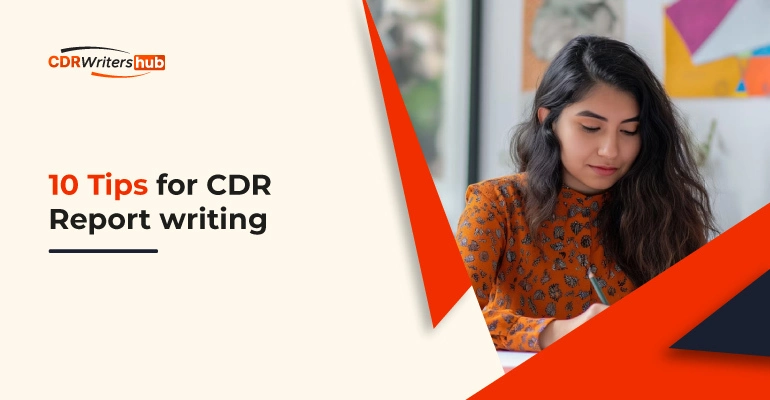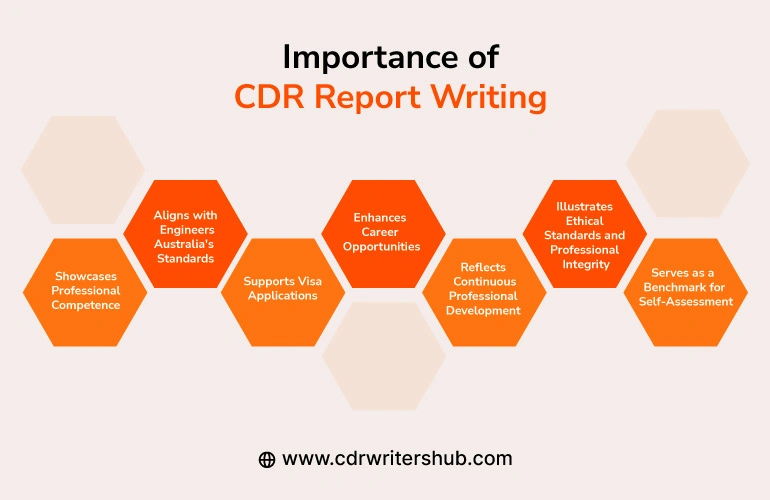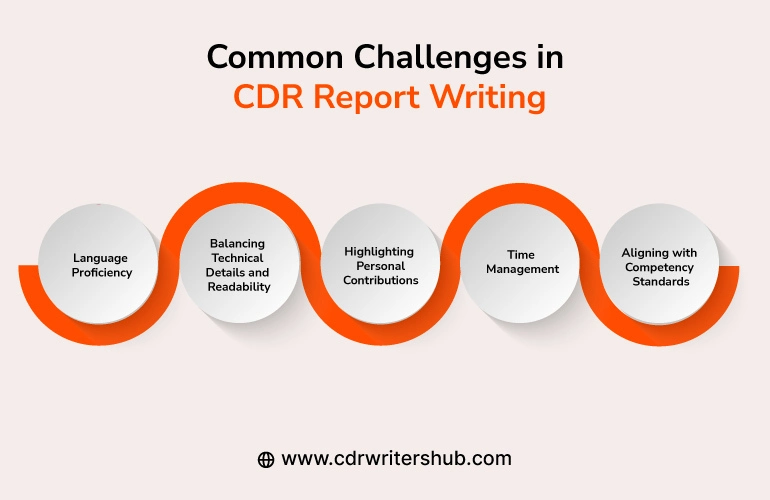10 important tips for writing an effective CDR Report for Australian migration

10 important tips for writing an effective CDR Report for Australian migration
Competency Demonstration Reports (CDR) are vital for engineers aspiring to migrate to Australia under the skilled migration category. A meticulously crafted CDR report demonstrates your engineering skills, knowledge, and experience to Engineers Australia, the organization responsible for assessing overseas engineers’ qualifications.
Given the importance of this document, it is crucial to understand the intricacies of CDR report writing to enhance your chances of a favorable assessment. This detailed guide will explore ten tips to help you excel in CDR report writing.
What is CDR report writing?
Table of Contents
CDR report writing is a critical process for engineers aspiring to migrate to Australia under the skilled migration category. This process involves creating a Competency Demonstration Report (CDR) that demonstrates an engineer’s qualifications, skills, and professional experience to Engineers Australia (EA), the body responsible for assessing overseas engineers’ credentials.
A complete CDR includes a continuous professional development (CPD) record, three detailed career episodes showcasing different engineering projects, and a summary statement that maps the competencies outlined in the career episodes to the required standards.
The CDR must be written clearly and concisely in English, emphasizing specific examples, technical details, and quantifiable achievements. It is essential to align the content with Engineers Australia’s competency standards while maintaining professional integrity and ethical conduct.
Due to its complexity, many applicants seek professional assistance to ensure their CDR is well-structured and compelling, enhancing their chances of a successful assessment and migration to Australia.
The Objectives of CDR Report Writing
The main objective of CDR report writing is to prove that the applicant possesses the necessary engineering competencies and standards as defined by Engineers Australia. These competencies are categorized into:
- Professional Engineer
- Engineering Technologist
- Engineering Associate
Each category has specific competency standards that must be addressed through the career episodes and the summary statement.
Importance of CDR Report Writing

The importance of CDR Report writing is immense for engineers aiming to migrate to Australia under the skilled migration category. A Competency Demonstration Report (CDR) is a comprehensive document that verifies an engineer’s skills, knowledge, and professional experience to Engineers Australia, the body responsible for assessing the qualifications of overseas engineers. Here are several reasons why writing a CDR is crucial:
1. Showcases Professional Competence
A CDR allows engineers to highlight their professional competencies according to Australian standards. By detailing specific projects and responsibilities, engineers can demonstrate their expertise, problem-solving skills, and technical abilities.
2. Aligns with Engineers Australia’s Standards
Engineers Australia has strict competency standards that applicants must meet to be recognized as qualified to practice in Australia. A well-prepared CDR ensures that an engineer’s qualifications and experiences meet these standards, making the assessment process smoother.
3. Supports Visa Applications
A positive CDR assessment is often necessary for obtaining a skilled migration visa to Australia. The CDR provides crucial evidence of the applicant’s engineering skills and readiness to contribute to the Australian workforce, which is essential for the visa application process.
4. Enhances Career Opportunities
A successful CDR assessment not only facilitates migration but also opens up better career opportunities in Australia. It indicates to potential employers that the engineer meets the high standards of professional practice required in Australia, thus enhancing employability.
5. Reflects Continuous Professional Development
The CPD section of the CDR demonstrates the engineer’s commitment to ongoing learning and professional growth. This is important for showing that the engineer stays updated with the latest advancements in their field, which is highly valued in the Australian engineering sector.
6. Illustrates Ethical Standards and Professional Integrity
Ethical conduct and professional integrity are fundamental to engineering practice in Australia. The CDR allows engineers to showcase their adherence to ethical standards and professional codes of practice, which is crucial for gaining trust and credibility in the Australian engineering community.
7. Serves as a Benchmark for Self-Assessment
Writing a CDR also serves as a self-assessment tool for engineers. It helps them critically evaluate their own experiences and achievements, identify gaps in their skills or knowledge, and plan for future professional development.
10 Tips for CDR Report Writing

Creating a Competency Demonstration Report (CDR) is an essential task for engineers aiming to migrate to Australia through the skilled migration pathway. The CDR highlights your qualifications, skills, and professional experience to Engineers Australia, the body that evaluates the credentials of international engineers.
To ensure your CDR is distinctive and meets the strict criteria, consider these ten crucial tips for effective CDR report writing.
1. Grasp the CDR Report Structure
Before you begin, it’s essential to understand the basic structure of a CDR Report. A complete CDR consists of the following sections:
A. Continuous Professional Development (CPD)
The CPD section highlights your ongoing efforts to keep your engineering skills and knowledge up-to-date. This section should be concise and include:
- Workshops, seminars, and conferences attended
- Postgraduate courses or other formal education
- Voluntary work and mentoring
- Reading technical literature or journals
Your CPD list should not exceed one A4 page and should be in a simple table format.
B. Three Career Episodes
The career episodes form the core of your CDR. Each episode is a narrative that describes a specific period or project in your engineering career. The aim is to demonstrate your application of engineering skills and knowledge. Each career episode should:
- Be written in the first person and use active voice
- Be between 1,000 and 2,500 words
- Focus on different aspects of your work to showcase a variety of competencies
- Highlight your role and contributions
A career episode is structured into four sections:
a. Introduction
- Duration of the project
- Location
- Name of the organization
- Your position title
b. Background
- Context of the project
- Objectives of the project
- Your specific role and responsibilities
c. Personal Engineering Activity
- detailed description of the work you performed
- Technical challenges you encountered
- How do you apply your engineering knowledge and skills?
d. Summary
- Overview of your project
- Achievements and outcomes
- Your contributions to the project’s success
C. Summary Statement
The Summary Statement is a critical component of your CDR. It is a mapping exercise where you link the competency elements required by Engineers Australia to the content in your Career Episodes. The summary statement should include:
- Identify relevant competency elements for your occupational category
- Reference specific paragraphs in your Career Episodes where each competency is demonstrated
- Be clear and concise
2. Select Relevant Projects for Career Episodes
Choosing the right projects for your Career Episodes is crucial. These projects should be significant and demonstrate a range of competencies. Consider the following when selecting projects:
a. Relevance to Your Engineering Discipline
Ensure that the projects you choose are closely related to your engineering discipline. For example, if you are a civil engineer, focus on civil engineering projects rather than unrelated tasks.
b. Highlight Your Role and Responsibilities
Choose projects where you played a significant role and can demonstrate your contributions. Emphasize your leadership, problem-solving skills, and technical expertise.
c. Diversity of Competencies
Select projects that showcase a variety of competencies. This provides a well-rounded picture of your skills and abilities to the assessors.
3. Use the STAR Method for Career Episodes
To effectively demonstrate your competencies, follow the STAR (Situation, Task, Action, Result) method when writing your Career Episodes:
a. Situation
Describe the context of the project. Provide background information about the project, including its purpose, scope, and role.
b. Task
Explain the specific tasks you were responsible for. Detail the challenges you faced and the objectives you aimed to achieve.
c. Action
Describe the actions you took to accomplish the tasks. Focus on your contributions, emphasizing the skills and knowledge you applied.
d. Result
Highlight the outcomes of your actions. Provide quantifiable results where possible, demonstrating the impact of your contributions on the project.
4. Be Specific and Quantify Your Achievements
When writing your CDR Report, particularity is key. General statements do not provide enough insight into your capabilities. To make your report compelling:
a. Use Concrete Examples
Instead of vague statements, use concrete examples to illustrate your points. For instance, rather than saying, “I improved the project’s efficiency,” specify how you did it, such as, “I implemented a new scheduling system that reduced project completion time by 20%.”
b. Provide Quantifiable Data
Wherever possible, include quantifiable data to back up your claims. Numbers provide a clear picture of your achievements and the impact of your work.
5. Align with Engineers Australia’s Competency Standards
Engineers Australia has specific competency standards that your CDR Report must meet. Download their guidelines and become intimately familiar with the format, content requirements, and assessment criteria.
This will be your roadmap to success. Familiarize yourself with these standards and ensure your report aligns with them:
a. Professional Engineer, Engineering Technologist, or Engineering Associate
Identify the competency standards relevant to your engineering category. Each category has different expectations and criteria.
b. Address Each Competency
Ensure that each Career Episode addresses the relevant competency elements. Use the Summary Statement to map these elements to your narrative.
6. Write in Clear, Concise English
Your CDR Report should be written in clear, concise English. Avoid jargon and overly complex sentences. Consider the following tips:
a. Use an active voice.
An active voice makes your writing more direct and engaging. For example, instead of “The project was completed by me,” write “I completed the project.”
b. Avoid Redundancy
Be concise and avoid unnecessary repetition. Every sentence should add value to your report.
c. Proofread and Edit
Carefully proofread your report to eliminate grammatical errors and typos. Consider using tools like Grammarly or seeking help from a professional editor.
7. Use the First Person in Career Episodes
Your career episodes should be written in the first person to convey your contributions and experiences. Use “I” statements to emphasize your role and actions. This approach helps the assessors understand your specific responsibilities and achievements.
Choosing the right projects for your Career Episodes is crucial. Ensure that the projects you select are:
- Relevant to your engineering discipline
- Significant in scope and complexity
- Able to demonstrate a wide range of competencies
Focus on projects where you played a key role and can highlight your contributions.
8. Include Technical Details
While it’s important to be clear and concise, don’t shy away from including technical details relevant to your projects. Engineers Australia looks for evidence of your technical expertise and problem-solving skills. Include:
a. Technical Challenges
Describe any technical challenges you faced and how you addressed them. This showcases your problem-solving abilities.
b. Engineering Principles
Explain the engineering principles and methodologies you applied in your projects. This demonstrates your technical knowledge and competency.
9. Maintain Ethical Standards
Engineers Australia places high importance on ethics and professional conduct. Your CDR report should reflect your commitment to ethical standards.
a. Professional Integrity
Describe situations where you demonstrated professional integrity and ethical decision-making.
b. Adherence to Codes of Practice
Mention any adherence to relevant codes of practice, regulations, or standards in your work.
10. Seek Feedback and Professional Assistance
Finally, consider seeking feedback and professional assistance to enhance your CDR report.
a. Peer Review
Have a colleague or mentor review your CDR report. They can provide valuable insights and identify areas for improvement.
b. Professional Services
Consider using professional CDR writing services if you’re unsure about your writing skills. These services can help you craft a compelling and well-structured report.
Common Challenges in CDR Report Writing

Writing a CDR can be challenging, particularly for engineers who are not familiar with the process. Here are some common difficulties and tips for overcoming them:
1. Language Proficiency
For non-native English speakers, writing a clear and concise report in English can be difficult. Improve your language skills by:
- Reading technical literature and engineering journals
- Practicing writing and seeking feedback
- Using language tools like Grammarly
2. Balancing Technical Details and Readability
Finding the right balance between technical details and readability is essential. Ensure your report is technically accurate but also easy to read. Avoid unnecessary jargon and explain complex concepts clearly.
3. Highlighting Personal Contributions
Emphasizing your contributions can be challenging, especially on team projects. Focus on your specific responsibilities and the impact of your work. Use first-person statements to convey your role.
4. Time Management
Writing a CDR is time-consuming and requires careful planning. Break down the process into manageable tasks and set deadlines for each stage. Allocate sufficient time for reviewing and editing your report.
5. Aligning with Competency Standards
Ensuring your CDR aligns with Engineers Australia’s competency standards can be challenging. Thoroughly review the competency standards for your occupational category and ensure each career episode addresses relevant elements. Use the summary statement to map these elements to your narrative.
Professional Support and Resources
Professional support and resources play a crucial role in the successful preparation of a competency demonstration report (CDR). Engaging with professional CDR writing services provides specialized guidance and personalized assistance, ensuring that the report aligns with Engineers Australia’s stringent standards.
These services offer valuable insights and help engineers craft compelling narratives that effectively showcase their competencies. Additionally, online engineering communities and forums serve as beneficial platforms for engineers to share experiences, seek advice, and learn from peers who have undergone the CDR process.
These interactions provide practical tips and diverse perspectives, enhancing the overall quality of the report. Moreover, participating in continuous professional development (CPD) programs and workshops is vital for maintaining and enhancing professional skills.
These programs not only bolster an engineer’s CDR by highlighting their commitment to ongoing learning and development but also ensure they stay updated with the latest advancements in their field.
Here are a few benefits of professional support and resources:
Assistance for CDR Writing Services
These professional services offer specialized guidance, tailored assistance, and comprehensive support throughout the CDR drafting process. They provide invaluable advice, ensure compliance with Engineers Australia’s standards, and assist engineers in developing compelling CDRs.
They can also assist in checking whether your content is plagiarized or not, and if yes, they can help you with it.
Utilization of Engineering Communities and Forums
Online platforms dedicated to engineering communities and forums serve as valuable avenues for engineers to exchange insights, seek guidance, and gain knowledge from peers’ experiences in composing CDRs.
Active engagement within these communities can yield valuable assistance and perspectives.
Participation in CPD Programs and Workshops
Enrolling in Continuous Professional Development (CPD) initiatives and workshops presents engineers with opportunities to refine their expertise, expand their understanding, and refine their competencies across various engineering domains.
Active involvement in CPD endeavors not only enriches an engineer’s CDR but also underscores their dedication to continual professional advancement.
Conclusion
In summary, CDR report writing is a critical step for engineers seeking to migrate to Australia. It serves as a detailed record of an engineer’s competencies and professional experience, aligns with Engineers Australia’s standards, supports visa applications, enhances career prospects, and highlights continuous professional development and ethical conduct.
Therefore, investing time and effort in creating a well-structured and compelling CDR is essential for engineers aiming for a successful assessment and a fulfilling career in Australia. By following best practices and potentially seeking professional assistance, engineers can create a compelling CDR report that effectively demonstrates their competencies and improves their chances of a positive assessment.
Mastering CDR report writing empowers you to take control of your migration narrative. By effectively communicating your engineering value, you open doors to exciting opportunities in the Australian engineering landscape.
Writing an effective CDR is a meticulous process that requires attention to detail and a strategic approach. By following these ten essential tips, you can create a compelling CDR that effectively demonstrates your competencies and enhances your chances of a successful assessment.
Frequently Asked Questions (FAQs)
- What exactly is a CDR?
A Competency Demonstration Report (CDR) is a document Engineers Australia requires from engineers aiming to migrate to Australia under the skilled migration category. It’s used to evaluate the qualifications, skills, and experience of overseas engineers to ensure they meet Australian standards.
- Why is a CDR important?
A CDR is crucial for engineers applying for skilled migration to Australia because it serves as proof of their engineering competencies. Engineers Australia utilizes the CDR to assess if the applicant’s qualifications and experience meet the standards necessary for engineering practice in Australia.
- What are the primary elements of a CDR?
The key components of a CDR are:
- Continuous Professional Development (CPD) list
- Three Career Episodes
- Summary Statement
Each part plays a distinct role in demonstrating the engineer’s engineering competencies and qualifications.
- What should the Continuous Professional Development (CPD) list contain?
The CPD list should encompass details of workshops, seminars, conferences, courses attended, voluntary work, and any other activities indicating ongoing professional development in the engineering field. It should be succinct and well-organized.
- How should career episodes be structured?
Every career episode should adhere to a structured format, including:
- Introduction: Provide an overview of the project or timeframe discussed.
- Background: describing the context and objectives of the project.
- Personal Engineering Activity: Detailing the engineer’s specific role, tasks, and responsibilities.
- Summary: Highlighting the outcomes, achievements, and the engineer’s contributions to the project’s success.
- What purpose does the summary statement serve?
The summary statement serves as a mapping exercise where the engineer connects the competency elements required by Engineers Australia to the content of their career episodes. It offers a clear overview of how the engineer’s experience and skills align with the competency standards.
- How can I ensure my CDR meets Engineers Australia’s competency standards?
To ensure compliance with Engineers Australia’s competency standards, meticulously review the standards applicable to your occupational category (Professional Engineer, Engineering Technologist, or Engineering Associate). Explicitly address each competency element in your career episodes and map them to your summary statement.
- What are some typical challenges in CDR report writing?
Common hurdles in CDR report writing include language proficiency, finding the right balance between technical details and readability, emphasizing personal contributions, managing time effectively, and aligning with competency standards. Seeking feedback and professional aid can assist in overcoming these obstacles.
- Is professional assistance available for CDR report writing?
Indeed, many engineers opt for professional help with CDR report writing. Professional CDR writing services provide expert guidance on structuring and drafting the report, reviewing the CDR report selecting pertinent projects, proofreading and editing, and ensuring alignment with Engineers Australia’s stipulations.
- How long does it typically take to complete a CDR?
The duration to complete a CDR can vary based on factors such as the complexity of your work experience, the clarity of your documentation, and your familiarity with the CDR requirements. It’s advisable to allocate ample time for thorough research, writing, and editing to ensure a high-quality submission.



